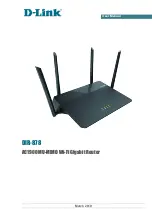
129
Since NAT acts as a “natural” Internet firewall, your router protects your network from access by
outside users, as all incoming connection attempts point to your router unless you specifically create
Virtual Server entries to forward those ports to a PC on your network. When your router needs to allow
outside users to access internal servers, e.g. a web server, FTP server, Email server or game server,
the router can act as a “virtual server”. You can set up a local server with a specific port number for the
service to use, e.g. web/HTTP (port 80), FTP (port 21), Telnet (port 23), SMTP (port 25), or POP3 (port
110). When an incoming access request to the router for a specified port is received, it is forwarded to
the corresponding internal server.
For example, if you set the port number 80 (Web/HTTP) to be mapped to the IP Address 192.168.1.2,
then all incoming HTTP requests from outside users are forwarded to the local server (PC) with the IP
address of 192.168.1.2. If the port is not listed as a predefined application, you need to add it
manually.
In addition to specifying the port number used, you also need to specify the protocol used. The
protocol is determined by the particular application. Most applications use TCP or UDP, however you
can specify other protocols using the drop-down
Protocol
menu. Setting the protocol to “all” causes all
incoming connection attempts using all protocols on all port numbers to be forwarded to the specified
IP address.
Summary of Contents for BiPAC 6200WZL R2
Page 11: ...7 Applications of 6200WZL R2...
Page 12: ...8 Chapter 2 Product Overview Important note for using this router...
Page 95: ...91 3 Choose the directory which you want to delete then click Delete to romove this directory...
Page 96: ...92 Samba Server...
Page 102: ...98 Step 3 To continue click Next Step 4 Select network printer and apply Next button...
Page 104: ...100 Step 7 Click Finish to complete the add printer...
Page 124: ...120 Enter the necessary message and press Reload Delete...
















































